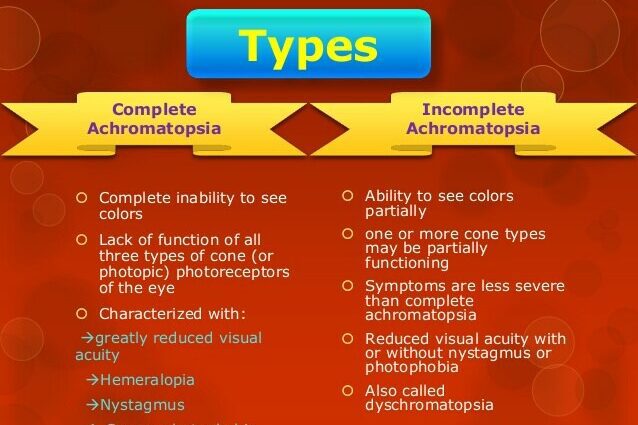Achromatopsia: definition, symptoms and treatments
Achromatopsia, also called achromatia, is a rare condition of the eye that prevents you from seeing colors. It has a genetic origin in most cases, but can also result from brain damage. Affected patients see the world in black and white.
What is achromatopsia?
Achromatopsia refers to the inability of a person to see colors. There are several forms:
Complete congenital achromatopsia
Due to genetic mutations in one or more genes involved in color vision, the retina that lines the back of the eye lacks so-called “cone” photoreceptor cells that distinguish colors and details in light. Result: affected patients see in shades of gray.
In addition, they have a high sensitivity to light and a very low visual acuity. All of this from birth. This color blindness being linked to recessive genes, it only concerns people whose two parents are carriers of the same mutation and have transmitted to it. This is why its prevalence is low, of the order of 1 case per 30 to 000 births worldwide;
Partial or incomplete congenital achromatopsia
This form is also genetic, but, unlike the first, it is linked to a mutation on the X chromosome and it does not affect all the cones of the retina. It leaves those sensitive to blue. This is why this pathology is also called “blue cone monochromatism”.
Patients with it do not see red and green, but perceive blue. Due to a lack of sufficient cones, their visual acuity is nevertheless very poor and they cannot tolerate light. Since incomplete achromatopsia is linked to a recessive mutation linked to the X chromosome, it mainly affects boys, who have only one copy of this chromosome (their 23rd pair of chromosomes is made up of an X and a Y ). Since girls have two X chromosomes, they must have inherited the mutation from both parents to be achromats, which is much rarer;
Cerebral achromatopsia
It is not of genetic origin. It appears following a brain injury or a cerebrovascular accident (stroke) affecting the visual cortex. Patients whose retina is normal and who have seen colors very well up to this point lose this ability either totally or partially. Their brains can no longer process this type of information.
What are the causes of achromatopsia?
Congenital achromatopsia is a genetic disease. Several genes can be involved:
- GNAT2 (chromosome 1) ;
- CNGA3 (chromosome 2) ;
- CNGB3 (chromosome 8) ;
- PDE6C (chromosome 10) ;
- PDE6H (chromosome 12) ;
- and, in the case of blue cone monochromatism, OPN1LW and OPN1MW (X chromosome).
While congenital achromatopsia manifests itself from birth, there are a few cases of acquired achromatopsia. They are caused by brain damage: trauma or stroke affecting the visual cortex.
In patients with mutations in one or more of these genes, the retina lacks the cones that allow us to see colors and details. They only have cells in “rods”, responsible rather for night vision, in shades of gray.
What are the symptoms of achromatopsia?
Congenital achromatopsia is characterized by:
- color blindness : this is total in complete achromats, who see the world in black and white, or almost total in monochromats, who still manage to distinguish blue;
- significant photophobia, that is, hypersensitivity to light;
- reduced visual acuity, between 1/10 and 2/10;
- un nystagmus, that is, an involuntary, jerky oscillation of the eyeball, especially in the presence of bright light. This symptom may fade with age;
- a central petit scotome, that is, one or more small spots in the center of the visual field.
This deficiency is present from a young age, but it is the aversion to light and the abnormal movement of their baby’s eyes that first alerts parents, especially if there are other cases in the family. When the child is old enough to express himself, a color test can be carried out but it is not enough, since some monochromats manage to adapt, to the point of being able to name certain colors. Only an electroretinogram (ERG), measuring the electrical activity of photoreceptors in the retina, can confirm the diagnosis. A genetic analysis then makes it possible to specify the mutation in question.
Congenital achromatopsia is a stable pathology. However, progressive degeneration of the macula, that is, the area in the center of the retina, may appear in some patients, especially as they become older.
Cerebral achromatopsia is only a sudden loss of color vision after a head injury or stroke.
How to treat achromatopsia?
There is currently no treatment for this pathology, only solutions to relieve the symptoms. Aversion to light and sensitivity to contrasts in particular can be improved by wearing glasses or contact lenses tinted red or brown, known as “chromogenic”. Magnifying glasses at high magnification may make it easier to read. There are also other aids to promote patient autonomy: training in locomotion, adapting the time to take university exams, etc.
Is prenatal diagnosis possible?
Yes. As achromatopsia is a disabling genetic disease, prenatal diagnosis can be offered to couples at risk, that is to say to couples in which both partners are carriers of mutations linked to this pathology. If it is the same mutation, they have a 25% chance of giving birth to an achromatic child.
In the case of monochromatism, only the mother can transmit the deficient gene to her offspring. If it’s a boy, he’ll be achromatic. If it is a girl, she will be a carrier of the mutation, like her mother.










